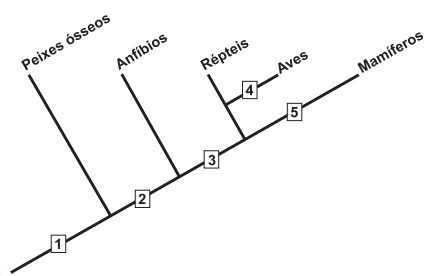THE caatinga is a Brazilian biome and has characteristics that contribute to the biodiversity of plant and animal species.
It is located mainly in Northeastern states such as Maranhão, Piauí, Ceará, Rio Grande do Norte, Paraíba, Pernambuco, Alagoas, Sergipe and Bahia. In addition, it also covers part of the state of Minas Gerais, making the Caatinga a biome that is present in 11% of the Brazilian territory, but considered the least explored Brazilian biome and, consequently, the least known.
The vegetation of the Caatinga is considered by many to be similar to a desert, as the dry climate and undergrowth make it impossible to plant several plant species.
Caatinga flora characteristics
The main characteristic of the flora of the Caatinga is the condition of survival of these plants, which are subjected to a dry climate with little amount of water.
Even under these circumstances, the caatinga is a favorable place for the growth and development of several plant species.
Check out other typical characteristics of the Caatinga flora:
- The bark of trees is thick;
- Tree stems have thorns;
- Leaves are small;
- The roots are tuberous to store water.
In general, the vegetation of the Caatinga is formed by three groups, namely:
- Arboreal: represents trees that are 8 to 12 meters tall;
- shrub: represents vegetation that is 2 to 5 meters high;
- Herbaceous: represents vegetation that is less than 2 meters high.
According to the Ministry of the Environment, around 900 plant species make up the caatinga biome, with bromeliads and cacti being the most common.
However, it is estimated that there are a much larger number of plant and animal species that have not yet been catalogued.
You may also be interested in:
- Caatinga
- Caatinga climate
- Caatinga Characteristics
List of Caatinga plants
Meet below 25 species of plants existing in the Caatinga.
1. Angico (Anadenanthera colubrina)

Angico is a tree famous for its white flowers that tend to attract honey bees.
Very common in different Brazilian biomes, especially in the Caatinga, thick and Atlantic Forest, Angico is characterized by its rapid growth.
It is a tree with a robust trunk that produces a high amount of tannin, a substance that prevents the attack of microorganisms that can cause disease.
The bark of the angico trunk also has medicinal properties, being indicated to reduce bleeding, fight diarrhea and help with skin healing.
2. Red mastic tree (Schinus terebinthifolius Raddi)

The red pepper is a native species of Brazil. Also known as pink pepper, it is very common in the Caatinga, but it can also be found in others. Brazilian biomes.
It has a trunk that can reach 80 cm in diameter, is dark brown and produces a wood resistant to deterioration, as it produces substances with fungicidal and insecticidal action.
As it is widely exploited, it is considered a species in the vulnerable category in the list of species of Brazilian flora that are threatened with extinction.
3. Big belly (Ceiba glaziovii)
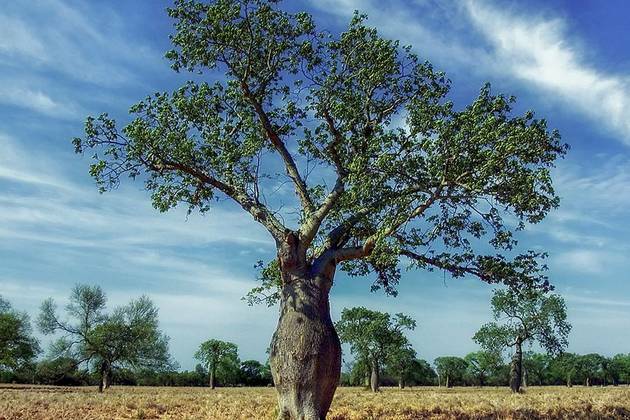
The belly is a tree often found in the Caatinga, especially for its ability to resist drought, as it has the power to absorb water in its interior.
Its stem can reach up to 1 meter in diameter, has a large amount of thorns and its wood is considered soft, light and has little durability.
It is also known as paineira, because the seeds are wrapped in the paina, released after their rupture and carried by the wind.
4. Bromeliad (bromeliaceae)

Bromeliad is a plant that belongs to the Bromeliad family, which has a multitude of species. The most popular species of bromeliad is pineapple, formed from the gathering of various flowers.
One of the characteristics of bromeliads is their leaves, which are usually long, narrow, curved and arranged in circular layers.
Due to the formation of leaves, they have a great capacity to store water, being heavily consumed by different species of animals.
5. Cactus (Cactaceae)
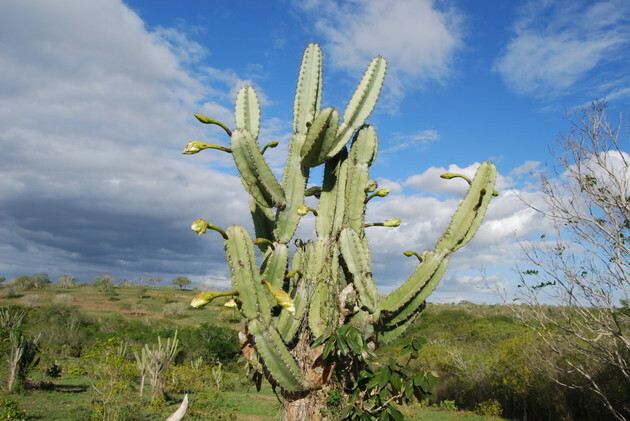
Cacti are very common in dry and hot environments, due to their high capacity to accumulate water, which is why it is so common in the Caatinga. It has a variety of species, some of which can reach up to 18 m in height.
They have a succulent stem, a cylindrical shape and many thorns, which are nothing more than the leaves that underwent transformations to adapt to the environment.
6. Carnauba (Pruniferous Copernicia)
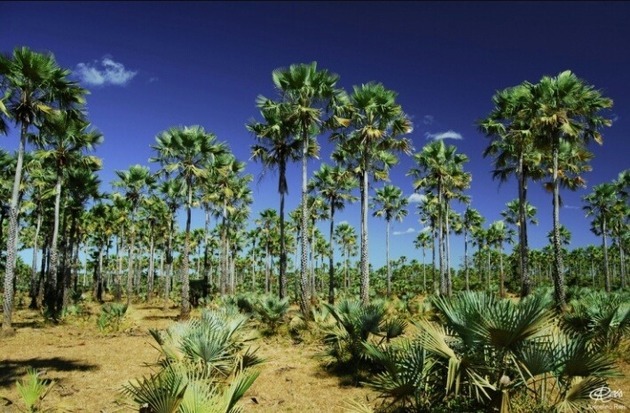
Carnauba is a very common palm in the Northeast region, whose main characteristic is its height, which can reach 15 m.
The stem is straight and cylindrical, with a diameter that can vary between 10 to 20 cm and has thorns at the bottom.
Its leaves are green and due to the wax they produce, they can have bluish tones. The wax produced in the sheet is a protection to prevent water loss, in addition to being used in the industry of various products and cosmetics, such as soaps and lipsticks.
7. Caroa (Neoglasiovia variegata)

Caroá is a type of bromeliad typical of the Caatinga and is also known as Gravatá, Caruá and Coronatá.
With few leaves, always in reddish or pinkish tones, it produces fibers used in the manufacture of handcrafted and decorative items, as well as fabrics, string and fishing line.
Published studies indicate the production of flavonoids that can help fight inflammation, pain and gastric ulcers.
8. Catingueira (Caesalpinia pyramidalis)

Catingueira is a species of tree widely distributed throughout the Caatinga that has the ability to regrow even after being cut. It is considered an indicator of the proximity of the rainy season, as its buds sprout when they feel the humidity.
The catingueiras usually measure between 4 and 8 m in height, the stem can reach up to 50 cm in diameter, as long as the root is in moist floodplains.
In dry climates, the catingueira presents a differentiated development, with shrubs smaller than 2 m and a stem with small diameters.
9. Crown of Friar (Melocactus bahiensis)

The crown-of-frade is a species of cactus typical of the Caatinga that presents a rounded, small and flat shape, reaching a maximum of 12 cm in height.
It is full of thorns that vary in thickness and size, in addition to having flowers in shades of pink and red, thus attracting many bees.
It receives this name because in its adult phase it presents the cephalium, which is visually very similar to a crown and a bald head, thus referring to a Franciscan friar.
10. Cumaru (Amburana cearensis)

The cumaru tree is typical of the Caatinga and can reach 20 m in height, has a trunk with a reddish bark that comes off in thin layers. They have pod-like fruits with a single oil seed.
Its husks and seeds are known to have medicinal use and can help in the treatment of respiratory problems.
11. Locksmith (Pilosocereus pachycladus)
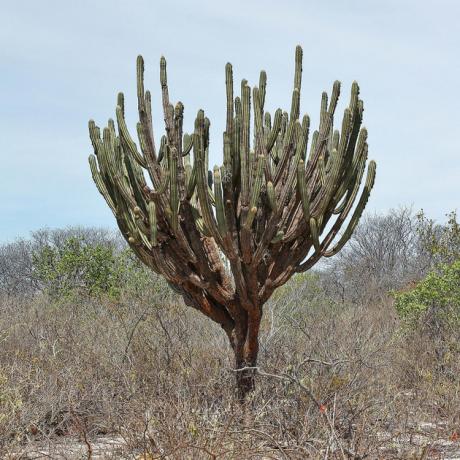
The torch is a species of large cactus, which can present up to 10 m in height.
It is a very rich plant nutritionally, with protein, fiber, tannin and starch, so when young it serves as food for animals as it does not yet have thorns.
In the adult stage, the shaman has a trunk and branches that vary from brown to dark green and its spines become sharp and yellowish.
12. Faveleira (Cnidoscolus phyllacanthus)

Faveleira is a plant endemic to the Caatinga known for its medicinal potential, especially in helping to heal wounds. It is easily found in rocky outcrops and shallow soil locations.
Very popular in the Northeastern states, the faveleira fruit is used as a toy by children, the seeds as part of the food of various birds and for human consumption as flour.
In recent studies, faveleira seed has been used in oil extraction for the production of biofuels, medicinal extracts and recovery of degraded areas.
13. jitirana flower
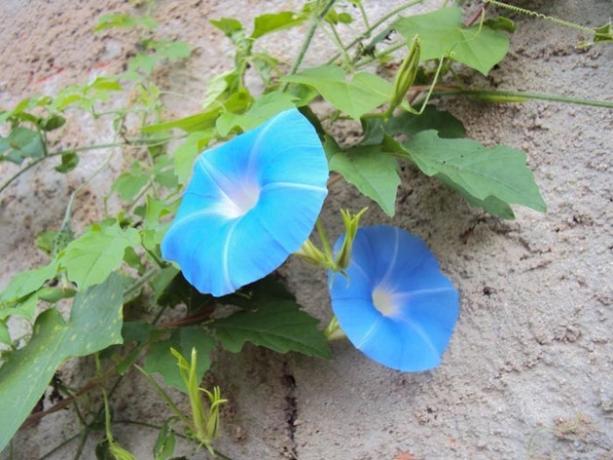
Jitirana flower is a typical Caatinga species that stands out for its high resistance to weather conditions and adaptability to the environment.
The vine type, the jitirana is succulent and with a pleasant odor, being widely accepted by animals. It is also consumed by man when using its leaves for teas, which is believed to help against dermatitis and rheumatism.
It is easily found growing in shrubs and fences, being considered by some as a weed, and can even cause damage in agricultural areas.
14. Purple IPE (Tabebuia impetiginosa Mart)

The purple ipe is a tree that is part of the northeastern landscape. It has a straight and fissured trunk, and its flowers are arranged in a single branch, forming a bouquet.
Seeds are light and easily spread by the wind. Wood is heavy, hard and resistant, yet flexible, being widely used in the construction of furniture and musical instruments.
In folk medicine, the parts of the ipe are used to help fight fever, dysentery, ulcers, rheumatism and venereal diseases. In addition, its bark has anti-inflammatory, anti-allergic and healing power.
15. Jericho (Selaginella Convolute Sprig)

Jericho is a typical species of the Caatinga and can often look like it is dead, as it spends most of the year with dry leaves. When the rainy season starts, it is one of the first plants to show a reaction, with the green color reappearing.
This species is also popularly known for its medicinal power, being used in the form of tea to combat flu and abdominal pain.
16. Juazeiro (Ziziphus jeweler)

The juazeiro is a tree with a thorny trunk, about 60 cm in diameter and can measure 10 meters in height.
One of its main characteristics is the ability to survive the Caatinga climate, especially due to its preference for alluvial soils of the clayey type, that is, that present sediment deposition that is transported by rivers.
It has deep roots that help in capturing water from the ground, giving them the ability to always have green leaves.
17. White Jurema (Piptadenia stipulacea)

The white jurema is a popular species in the Caatinga and is also known as carcará, jurema, lip-ripper and old-skirt.
Endemic to the Caatinga, the white jurema is commonly found on roadsides, as it has an invasive behavior, thus supporting dry terrain.
The jurema-branca wood is used in small constructions, for making stakes and also for use as firewood and charcoal. In the dry season, the leaves and chips from the trunk that fall to the ground become food for ruminants.
18. Malice (Mimosa quadrivalvis L.)

Malice is a very common herbaceous species in the Caatinga, Cerrado and Atlantic forest. Possessing branches and fruits covered by small thorns, the aculeus, malícia is easily found in open areas.
The region's native bees are attracted by the pollen and nectar expelled by its flowers.
19. White mallow (Cordifolia L)

Mallow is a species easily found in the Caatinga, and can also be seen in the Cerrado, Atlantic Forest and Amazon.
It is a type of shrub that occurs in land with sandy soil, has yellow and orange flowers. Pollen and nectar are an attraction for bees and for honey production, being widely used in honey flora gardens.
20. Mandacaru (Jamaican Cereus)
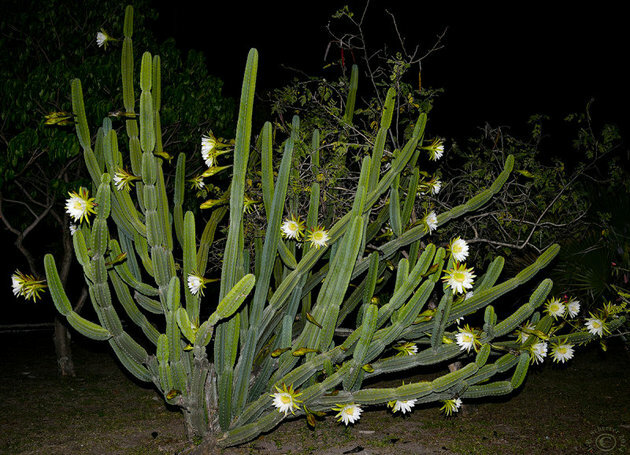
Mandacaru is a species of cactus endemic to Brazil and very common in places with climates such as the Caatinga. Its shape resembles a chandelier and can measure up to 6 meters in height.
It is a plant full of thorns, with great water retention capacity and widely used as a natural fence. In addition, its fruits and its flower serve as food for birds and bees.
21. Palm (Cochenillifera prickly pear)

The palm is a type of cactus originating in Mexico and very widespread in northeastern Brazil, being also known as urumbeta, cochineal cactus, sweet palm, thornless cactus, among others names.
It has a cylindrical stem and its branches are the palms, which have a flat, fleshy and oval shape.
Its use is very wide, and it can be consumed in human and cattle feeding, as a landscape element and in the production of natural coloring.
22. Quixaba (Sideroxylon Obtusifolium)

The quixaba tree is known for its medicinal power, especially for the treatment of kidney-related diseases and diabetes.
It can reach 15 meters in height, it has strong spines, elongated leaves, aromatic flowers and purple fruits that can be consumed by people.
23. You knew (Mimosa caesalpiniaefolia)

The thrush is a native tree of the Brazilian Northeast, with records mainly in the states of Piauí, Pernambuco, Alagoas, Rio Grande do Norte, Paraíba, Bahia and Ceará.
Up to 8 meters high, this tree has a stem with a diameter between 20 and 30 cm, which branches into other small stems.
Its wood is widely used in the production of stakes for fences and for energy, featuring its potential for use as firewood and charcoal.
24. Umbuzeiro (tuberous spondias)

The umbuzeiro is a large tree that has the Caatinga as its natural habitat. It can reach 7 meters in height, but its trunk is short and the crown is wide, shaped similar to an umbrella. Its root has a great capacity to store water.
It has white flowers that cluster together, are fragrant and usually attract bees that consume its nectar to produce honey.
The fruit of the umbu tree is highly appreciated by humans for its sweet smell, pleasant flavor and slightly sour. The root is also consumed as food, believed to have medicinal power that prevents diarrhea.
25. Xique-xique (pilocereus gounlei)

Xique-xique is a very common cactus species in the Caatinga, especially in the states of Ceará, Rio Grande do Norte, Bahia, Piauí, Paraíba, Pernambuco, Alagoas and Sergipe.
It tends to develop in dry places with shallow soil, especially between rock crevices.
It has an erect trunk with lateral branches that are spaced apart and can measure up to 4 meters in height. Its thorns are strong and its fruit is appreciated for being rich in minerals and tasty.
Also read about:
- Flora of Brazil
- Caatinga Animals
- Atlantic Forest Animals
- Animals of the Cerrado
- Pantanal Animals
- Pampa animals
- Amazon Animals

